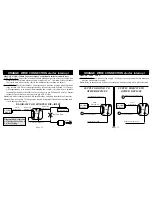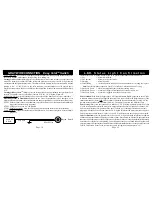
Page
Page
-6
-7
A r m i n g F r o m T r a n s m i t t e r
Arming Alarm From Transmitter: The alarm can always be armed from the transmitter if the
ignition key is “Off” and the alarm is in the disarmed condition and not in the valet condition. To arm
the alarm after you exit the vehicle and close all doors, simply Press The Large Transmitter Button Once.
Instantly the lights will flash once, the siren will chirp once, and the L.E.D. light will begin flashing
continuously, confirming that the alarm is armed. Provided optional relays are installed, the doors will
lock, and the optional starter interrupt relay will prevent any attempt to start the vehicle.
Note About Arming By-Pass: When oversized objects are placed in the vehicle's trunk that prevent
the trunk lid from closing or if any ( - ) trigger circuit is inoperable, then only that circuit will be
bypassed. For example, if the trunk is left open, then you can still arm the system from the transmitter.
The bypassed circuit will automatically be reinstated for protection the instant that circuit becomes
operative, i.e., the trunk is closed. The arming confirmation now changes from one siren chirp to 3
chirps and one light flash to 3 light flashes to advise you that the alarm armed with the bypass circuit
operating.
Pre-Warn Circuit By-Pass: After pressing the large transmitter button to arm the security system, you
will hear a siren chirp to confirm that the system will arm in 3 seconds. Within 2 seconds of hearing
the arming chirp confirmation, press both transmitter buttons. You will hear another siren chirp
confirming the security system has armed without the pre-warn circuit protecting the vehicle. The next
time you arm the alarm, the security system will reset to its normal condition and the pre-warn circuit
will be part of your protection again.
You can pre-select your security system to automatically arm and lock the doors. This information
is described on page 15.
While the alarm is armed, the L.E.D. light will be flashing. In this mode, any unauthorized entry
will instantly trip the alarm. Once tripped, the following will occur:
1) Siren will start sounding and every 5 seconds the siren will change its sound to generate
more attention to the vehicle.
2) Lights will flash for 60 seconds.
3) Doors will re-lock instantly in case the thief unlocks a door to gain entry. This feature is so
technologically advanced and unique to this security system that it even knows when a
door(s) is opened and, if so, the system waits until the door(s) is closed to re-lock the door(s)
instantly, insuring that the thief cannot easily regain entry. Another reason to delay the doors
from locking is that most vehicle manufacturers design the vehicle's doors to automatically
unlock when the door is closed after being locked while open. This is to reduce the risk of
locking yourself out of your vehicle.
All three functions above will stay active for 60 seconds, unless you disarm the system with the
transmitter or valet override switch. If all protected entries are secure at the end of 60 seconds, the alarm
will stop and re-arm automatically to detect another entry. If there is a protected entry still open or
a sensor still in a triggered state at the end of 60 seconds, the alarm will re-trigger for two more 60
second cycles. The alarm will stop in 3 minutes and re-arm automatically while ignoring only the open
entry or triggered circuit. When that circuit is reset, fixed or closed, then protection will instantly begin
from that circuit.
After the security system automatically shuts-down and re-arms after being triggered, the disarm
confirmation will no longer be 2 chirps & the lights staying on for 60 seconds. Instead, the system will
respond by producing 4 siren chirps & flashing the lights 4 times before the lights stay on for 60 seconds.
The L.E.D. light will change from being "off" to flashing one, two, or three times, then pausing 1 second
to indicate which protected zone triggered the system. The L.E.D. will continue flashing this violation
code until the ignition key is turned “on”, thus clearing the alarm's LED light memory circuit.
A l a r m A r m e d A n d T r i g g e r e d





































